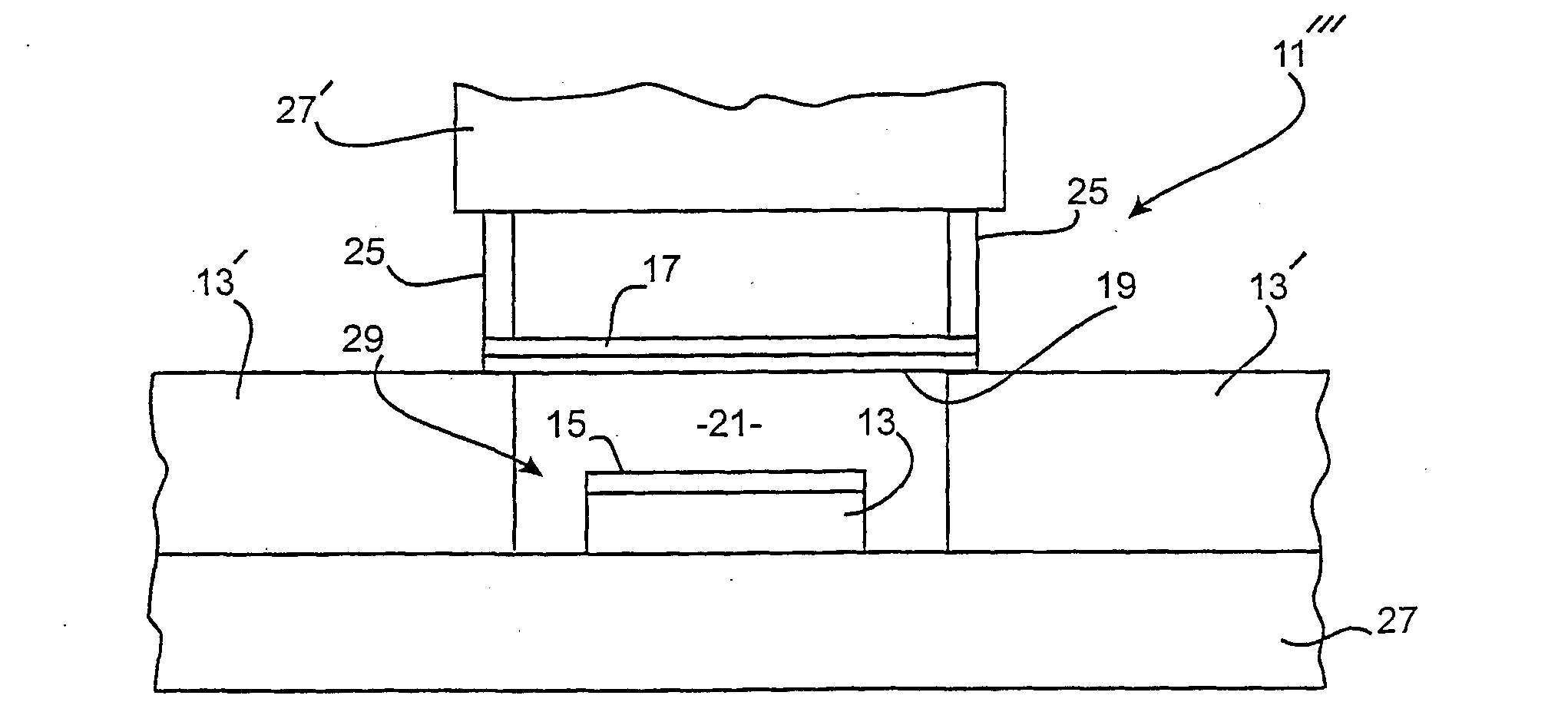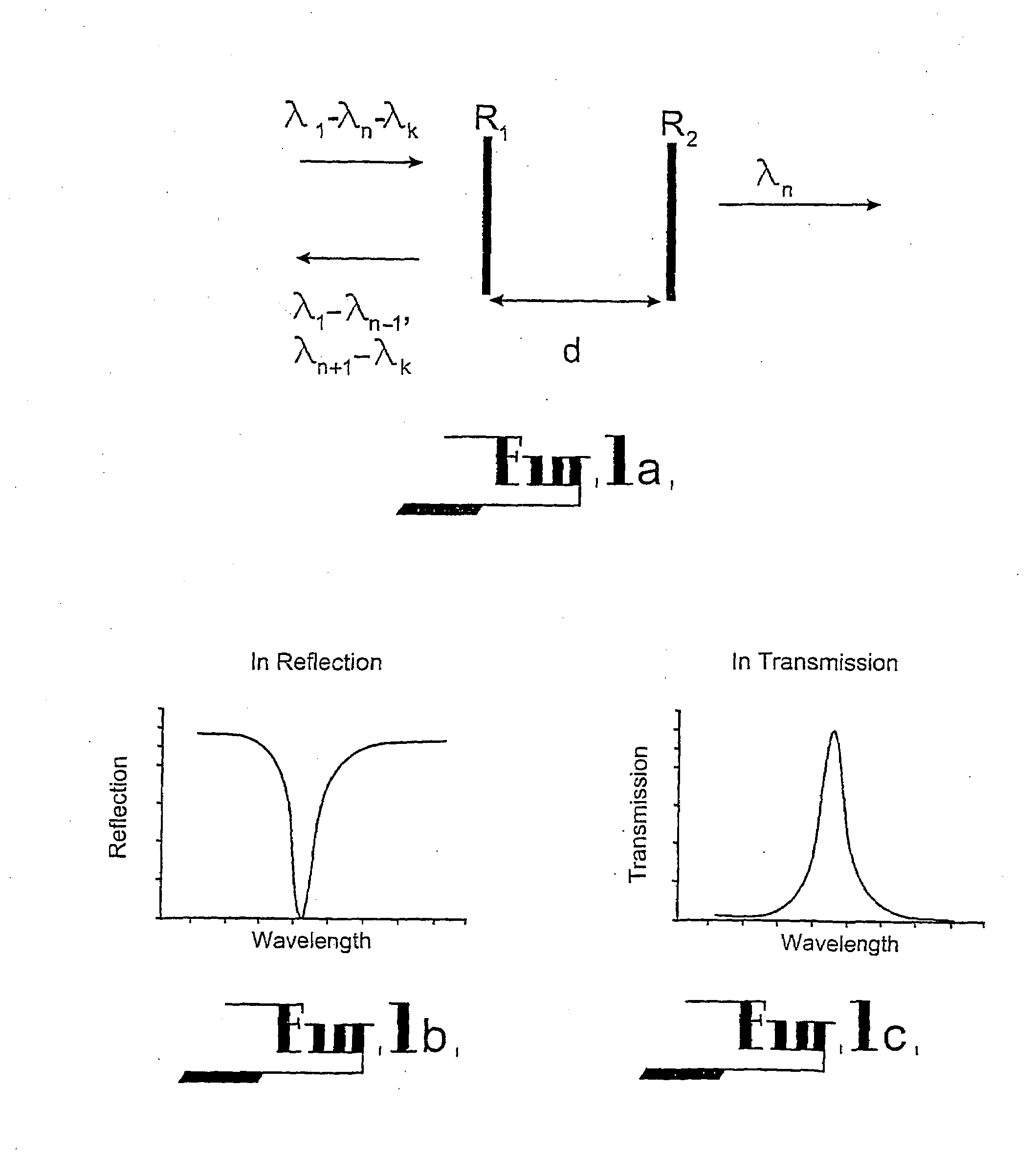Tunable cavity resonator and method for fabricating same
a resonator and cavity technology, applied in the direction of optical elements, optical radiation measurement, instruments, etc., can solve the problems of limited application of such resonator technology to short wavelengths (less than 1.6 m), unsuitable application types of resonator devices, and general limitations of such resonator devices, so as to achieve efficient optical generation and detection, easy modification, uniform layer uniformity and flatness
- Summary
- Abstract
- Description
- Claims
- Application Information
AI Technical Summary
Benefits of technology
Problems solved by technology
Method used
Image
Examples
first embodiment
[0151]fabricating a tunable cavity resonator is made with reference to FIG. 7 of the drawings.
[0152]As shown in FIG. 7A, a chrome / gold layer 51 of 2 nm chrome and 50 nm gold is thermally evaporated on to a silicon substrate 53 to act as the lower reflector as well as the lower electrode of the cavity. This layer 51 is also required to promote adhesion between the zinc sulphide sacrificial layer and the silicon substrate during the PECVD process. Without this layer, the adhesion of the sacrificial layer to the silicon substrate would be so low that during the PECVD process at 300° C., thermal stresses between the two materials would cause the sacrificial layer to peel off from the substrate.
[0153]As shown in FIG. 7B, the zinc sulphide sacrificial layer 55 is then thermally evaporated onto the substrate composite of FIG. 7A, the thickness of this layer corresponding to the final relaxed cavity length of the resultant cavity resonator. During the sacrificial layer deposition, the silic...
second embodiment
[0169]Now describing the second embodiment in more detail, reference is made to FIGS. 8 and 9 of the drawings.
[0170]As shown in FIG. 8A, a Cr / Au mask layer 71 is deposited on a GaAs substrate 73. A 3 μm thick sacrificial layer of ZnS 75 is then thermally deposited onto the substrate composite of FIG. 8A, as shown in FIG. 8B.
[0171]ZnS is normally thermally deposited with high intrinsic compressive stress onto a silicon or Si substrate, as ZnS has low adhesion to Si, but adheres much better to a bare GaAs wafer with no peeling after deposition. However, during the PECVD SiNx membrane deposition process, the ZnS nonetheless sometimes peels from the substrate. This is believed to be due to the differential expansion between the two materials. Thus, the thin layer of Cr / Au 71 is first deposited on to the substrate 73 to enhance the adhesion between the ZnS and GaAs substrate, acting as a buffer layer for thermal expansion during the PECVD process and for the compressive stress present be...
third embodiment
[0185]the invention is substantially the same as the previous embodiment, without transferring the MEMS structure from the GaAs substrate to the MCT substrate, so that the final device is actually formed on the GaAs substrate.
[0186]Moreover, after the ZnS sacrificial layer is removed by wet etching, the device is rinsed and dried. The drying stage is most critical due to the adhesion effects of surface tension forces in the rinse liquid. A layer of rinse liquid is effectively trapped under the membrane (in the cavity) during the rinse process. As the device dries, this liquid evaporates causing strong surface tension forces to be exerted between the substrate and the membrane. These forces pull the membrane down into contact with the substrate when Van der Waals forces often create permanent adhesion, rendering the device useless.
[0187]To overcome this problem, the device is rinsed in distilled-deionised water followed by an acetone soak to dehydrate the device.
[0188]A rinse solutio...
PUM
| Property | Measurement | Unit |
|---|---|---|
| wavelengths | aaaaa | aaaaa |
| wavelengths | aaaaa | aaaaa |
| wavelength | aaaaa | aaaaa |
Abstract
Description
Claims
Application Information
 Login to View More
Login to View More - R&D
- Intellectual Property
- Life Sciences
- Materials
- Tech Scout
- Unparalleled Data Quality
- Higher Quality Content
- 60% Fewer Hallucinations
Browse by: Latest US Patents, China's latest patents, Technical Efficacy Thesaurus, Application Domain, Technology Topic, Popular Technical Reports.
© 2025 PatSnap. All rights reserved.Legal|Privacy policy|Modern Slavery Act Transparency Statement|Sitemap|About US| Contact US: help@patsnap.com



